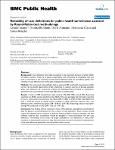Reliability of case definitions for public health surveillance assessed by Round-Robin test methodology
Krause, Gérard
Brodhun, Bonita
Altmann, Doris
Claus, Hermann
Benzler, Justus
Background: Case definitions have been recognized to be important elements of public health surveillance systems. They are to assure comparability and consistency of surveillance data and have crucial impact on the sensitivity and the positive predictive value of a surveillance system. The reliability of case definitions has rarely been investigated systematically. Methods: We conducted a Round-Robin test by asking all 425 local health departments (LHD) and the 16 state health departments (SHD) in Germany to classify a selection of 68 case examples using case definitions. By multivariate analysis we investigated factors linked to classification agreement with a gold standard, which was defined by an expert panel. Results: A total of 7870 classifications were done by 396 LHD (93%) and all SHD. Reporting sensitivity was 90.0%, positive predictive value 76.6%. Polio case examples had the lowest reporting precision, salmonellosis case examples the highest (OR = 0.008; CI: 0.005–0.013). Case definitions with a check-list format of clinical criteria resulted in higher reporting precision than case definitions with a narrative description (OR = 3.08; CI: 2.47–3.83). Reporting precision was higher among SHD compared to LHD (OR = 1.52; CI: 1.14–2.02). Conclusion: Our findings led to a systematic revision of the German case definitions and build the basis for general recommendations for the creation of case definitions. These include, among others, that testable yes/no criteria in a check-list format is likely to improve reliability, and that software used for data transmission should be designed in strict accordance with the case definitions. The findings of this study are largely applicable to case definitions in many other countries or international networks as they share the same structural and editorial characteristics of the case definitions evaluated in this study before their revision.

